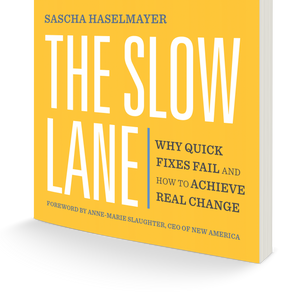On my quest to find what works to accelerate positive social change, I stumbled into the Slow Lane, a universe of communities and movements that strive for social change without compromising on inclusion and empowerment. It was easy to overlook the Slow Lane in a world that desires only quick fixes. But as I wrote in my last posts, the quick fixes offered by our leaders in business, government or even at home, end up doing a lot more harm than good. I found that people in the Slow Lane create solutions that don't simply patch over a problem, but take aim at the injustices and broken systems that keep producing failure in the first place. Theirs is a sophisticated practice, at once audacious in its vision, but also deeply committed to take the time to engage in messy human needs. The results can be progress that is both truly transformational and inclusive.
The Fast Lane, Tailored for Dominance.
Let me briefly remind you of how the Fast Lane works: A lot of things happen really fast around us. Amazon delivers in a day. Many of the apps we use give us instant gratification. New solutions come seemingly out of nowhere, and within a few years they are everywhere! The secret behind this speed is simple: avoid anything that slows you down. This is the way of the Fast Lane. It is why people who can’t get a credit card can’t get an Uber. Tesla cars sell fast because they are for the rich. Facebook looks past hate speech or fake news to grow faster. But, the things that would slow things down are often the hard truths about divisions, inequalities or inequities in our society. By excelling at finding short-cuts around these issues, they only reinforce the divisions that plague us. A similar dynamic plays out in politics, when leaders assert their 'leadership' by rushing to quick-fixes that end up hurting millions instead of engaging with the people whose lives are at stake.
The Fast Lane is tailored to a society that celebrates dominance as a means of success. A perpetual cycle of solving one problem by creating another.
Dominance is power and influence over others. And the Fast Lane is a product of a society that celebrates dominance as success. That's why, when we think about progress, we think of it mostly by the standards of the Fast Lane. Steve Jobs invented the iPhone, Jeff Bezos built Amazon or Elon Musk's electric car and space ventures. Why are these first to come to our mind? Why do we believe that this is what change looks like: heroic stories of disruption and dominance? As they impose their visions on us, these visionaries inevitably break with the values we hold dear in our human relationships. If success equals dominance, won't they choose speed and automation over inclusion and real conversation every time, feeding the divisions among us? The Fast Lane simply isn’t designed to be an instrument of social change.
The Slow Lane, Change at the Speed of Trust.
When I saw the work of User Voice inside Pentonville Prison, I realized that they are moving in the other direction (see Story #1). They aren’t looking for a quick fix, but try to slow things down. They don’t simply boil the lives of prisoners down to data. Instead, they carefully create the kind of trusted conversation that brings people together until their needs are met. It is a template for how we can approach the many needs and problems overlooked by the Fast Lane. This is why the Slow Lane is needed. It offers a better answer by building bridges where the Fast Lane breeds division.
This kind of slowness is a sign of care, of true inclusion, of not being afraid to get involved with humans. It is the kind of human mess that engineers and venture capitalists would hate. But it works.
The Slow Lane is big a collection of movements, and the best way to understand it is to observe how they work. User Voice, for example, is a movement that brings together prisoners, ex-offenders, their families, donors, health services, prisons and their governors to better achieve the goal of the prison and probation system: successful rehabilitation. Like User Voice, each of the millions(!) of movements in the Slow Lane has their specific purpose, a vision for change, in which a social problem or need can be solved. Slow Lane visions can appear outlandishly bold. For example, in 1970 it was unthinkable for a same-sex couple to be granted a marriage license in Minnesota. Homosexuality, at the time, was still classified as a disorder. And yet, a Slow Lane community had formed there around the idea of marriage equality, leading to a predictably unsuccessful attempt in the same year by Jack Baker and Michael McConnell to obtain a marriage license. Being first, they fought their way to the Supreme Court – and lost. But they got the ball rolling, and forty-five years later, in 2015, the U.S. Supreme Court ruled that all states must issue same-sex marriage licenses.
Countless communities in the Slow Lane pursue such seemingly audacious goals today. I will feature some of the most instructional stories in the coming chapters. Taken together, they offer us a glimpse of exciting new futures. But this audacity and persistence isn’t a gimmick. It is a necessary reminder of the work ahead of us. Slow Lane communities exist because the status-quo remains intolerable for so many.
The Long History of Going Slow.
People have known the perils of rushing to action for thousands of years. Philosophers, religions and folktales caution us against not just rushing, but also the arrogance that comes with moving fast. I, myself, am a relative late-comer to slowness, not paying all too much heed to these tales. But as I began to see the Slow Lane, it was Denisa Livingston, a friend and community health activist in Navajo Nation, who pointed me to the Slow Food movement. I had come across Slow Food when I was a teenager, passing a restaurant with a sign reading “No Fast Food here, just Slow Food!”. In my mind, I had filed it away as a snobby culinary alternative to fast food. But Denisa kindled my curiosity, and I began to read up on the Slow Food movement. It had grown into a global community of hundreds of thousands of members promoting not just good food and wine, but clean food (meaning healthy to humans and the environment) as well as fair food, referring to the treatment of the people involved in the production and processing of food. Slow Food, I soon learned, is a Slow Lane movement in and of itself. Over 35 years it had evolved from a regional producers lobby in Italy into a global human, economic and environmental rights movement. The kind of movement that now is a useful platform even to native activists like Denisa. Slow Food is only the most recognizable among many movements that promote slowness in fields like medicine, cinema, cities (cittaslow), fashion, technology and travel.
The Five Ways of the Slow Lane
After studying more than a hundred Slow Lane movements over the past two decades, I found that what really unifies the Slow Lane is not what they do, but how these movements go about changing things. To avoid the kind of negative effects of the Fast Lane, these slow-laners adhere to a set of principles that guide their actions. My research led me to five Slow Lane Principles that stood out as universal and timeless. You will recognize them throughout the examples in this book. They are simple, but can be practiced in sophisticated ways by people, movements, businesses, organizations, and even governments.
Slow Lane Principle #1: Hold the urgency.
Don’t sacrifice inclusion, participation, or sustainability for the sake of rushing to action. The Slow Lane strives to find solutions for everyone, in keeping with the ancient slogan “Nothing about us, without us”, brought to life by disability activists around the world in the 1990s. Iceland did just that, when during the financial crisis it resisted the impulse to restore the old order, and instead invited citizens to rewrite their constitution. Holding the urgency is to know that rushing to action won't get us there faster.
Slow Lane Principle #2: Listen.
Don’t pretend. Act with the humility to know the limitations of your listening. How you listen reveals whether you intend to treat others as equal contributors. User Voice broke the toxic power dynamics in the probation system by recruiting ex-offenders to do the listening. This kind of listening is essential to build the kind of trust that can change hearts and minds, allow something new to emerge, and keep people involved for the long haul.
Slow Lane Principle #3: Share the agency.
Don’t impose your answers. Create an environment in which even the least prepared people can find comfort and have the capacity, capability, and power to choose freely if they wish to join, contribute and exert their power. User Voice engages and trains prisoners to give them a say in their rehabilitation journey. In the Slow Lane, empowerment is practiced with patience and care, meaning that this invitation meets people where they are, and remains open to anyone, at all times.
Slow Lane Principle #4: Nurture Curiosity.
Don’t lock into a single answer. Curiosity makes the Slow Lane more inclusive and allows transformative visions to emerge. Curiosity lets us unlearn our preconceptions and open up to new ideas. Curiosity also lets us seek inspiration from outside our immediate reality, for example from science or other movements. Without curiosity, User Voice might have become an activist prison rights movement that works against prisons, feeding on frustrated prisoners and their families. Instead, their lived experience and research revealed opportunities to work with prison leaders to improve outcomes for all. Curiosity helps movements retain the flexibility to find common ground.
Slow Lane Principle #5: Use Technology as an Enabler.
Don’t use technology to dominate others. Instead, develop strong human values, principles and behaviors that technology can enable. Successful Slow Lane movements have rewritten the tech playbook to withstand the growth mindsets that reduce complex human needs to what engineers believe they can solve. Tech in the Slow Lane is owned by everyone, and it uses creative new ways to enable the best in human relationships.
Many communities have extended the Slow Lane Principles to fit their needs. You will find these principles tailored to the use of data and technology, public service delivery, community development or waste management.
These Slow Lane Principles have been adopted so widely because they give communities a lot of freedom to pursue whatever mission they have. They allow for diversity of thought and mission whilst maintaining some shared principles that allow us to collaborate. They also create the kind of human dynamics we naturally enjoy, and empower us to change things whilst minimizing harm to others. Also, they have proven to make the Slow Lane resilient in the face of countless challenges and tempting opportunities. As we dive into the stories of The Slow Lane book, we will discover the beauty and sophistication by which these principles have been applied. The Slow Lane is all the more remarkable because it has no prescribed ideology, manifesto, law or regulation. The Slow Lane has evolved as a practice because this is what works and comes natural to so many.
Fast Failed. It's Time for The Slow Lane.
As we emerge from a period of particularly challenging shocks to our lives, economies, democracies and ecology, the Slow Lane has only grown in importance. There was no war or natural catastrophe to blame as the cause of the financial crisis in 2007/8. It was entirely man-made and laid bare a social and economic order that, to many people, felt unjust as they suffered through government austerity programs, public service cuts and economic hardship. After decades of believing in a Fast Lane world of inventions, markets and growth, many people have begun to see its limits. It offers no fix to what is broken in our communities. It seems only fitting that this period was capped by a global pandemic, unrest over persistent racism, and economic collapse hitting the most vulnerable people hardest.
More and more people are searching for alternatives. They want to move past this endless cycle of division and inequality. The Slow Lane offers a compelling alternative. It optimizes for what we know to be true social progress: Care, respect, inclusion, justice, curiosity, humanity. It is a space of creativity, activism, and entrepreneurship that serves as our repository of social imagination. The Slow Lane Principles that connect its millions of disparate moving parts aren't new, but the product of age-old wisdom. It’s unifying idea is simple: Meaningful social change is possible, and we can solve one problem without creating another. It is not surprising, then, that the Slow Lane is a system of staggering proportions. Millions of people, organizations, businesses, and governments are active in the Slow Lane today.
We can apply the Slow Lane Principles in the privacy of your family meal, at work, in our business, or when we step up in public. Personally, seeing these principles in action freed me to open up, listen and trust that others will do right. It wasn't easy at first. I have been brought up with strictly Fast Lane values, and like many entrepreneurs, developed a habit of inducing crisis to create urgency around my ideas. What else could be more important? Trying on slowness felt like playing the trust fall, where you let yourself fall, hoping that someone will catch you. In this case, I was hoping the Slow Lane would deliver. And there it was. Over and over, I found that when I stopped insisting on getting things done right away (= my way), new, much more creative outcomes became possible, as those around me really got a chance to contribute and express themselves. We built a community that got stronger every day. It was impossible to predict how long it would take or where it would lead. And some things never got done because they didn't matter at all.
And I quickly learned a new habit: If it is really urgent, going slower will get us to the right place, faster.



